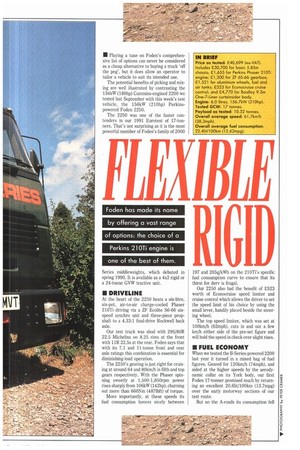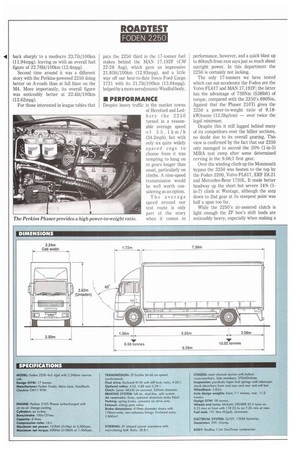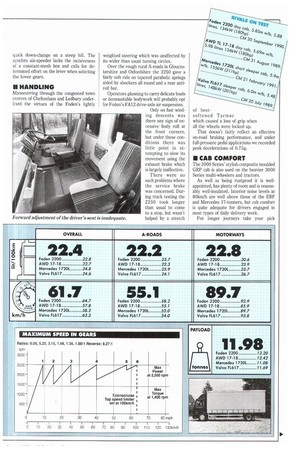FLEXIBLE RIGID
Page 31

Page 32

Page 33

Page 34

If you've noticed an error in this article please click here to report it so we can fix it.
• Playing a tune on Foden's comprehensive list of options can never be considered as a cheap alternative to buying a truck 'off the peg', but it does allow an operator to tailor a vehicle to suit its intended use.
The potential benefits of picking and mixing are well illustrated by contrasting the 134kW (180hp) Cummins-engined 2200 we tested last September with this week's test vehicle, the 156kW (210hp) Perkinspowered Foden 2250.
The 2250 was one of the faster contenders in our 1991 Eurotest of 17-tonners. That's not surprising as it is the most powerful member of Foden's family of 2000 Series middleweights, which debuted in spring 1990, It is available as a 4x2 rigid or a 24-tonne GVW tractive unit.
• DRIVELINE
At the heart of the 2250 beats a six-litre, six-pot, air-to-air charge-cooled Phaser 210Ti driving via a ZF Ecolite S6-66 sixspeed synchro unit and three-piece propshaft to a 4.33:1 final-drive Rockwell back axle.
Our test truck was shod with 295/80R 22.5 Michelins on 8.25 rims at the front with 11R 22.5s at the rear. Foden says that with its 7.1 and 11-tonne front and rear axle ratings this combination is essential for diminishing-load operation.
The 2250's gearing is just right for cruising at around 64 and 80km/h in fifth and top gears respectively. With the Phaser spinning sweetly at 1,500-1,850rpm power rises sharply from 106kW (142hp), churning Out more than 660Nm (4871bft) of torque.
More importantly, at these speeds its fuel consumption hovers nicely between 197 and 205g/kWh on the 21011's specific fuel consumption curve to ensure that its thirst for dery is frugal.
Our 2250 also had the benefit of Z523 worth of Econocruise speed limiter and cruise control which allows the driver to set the speed limit of his choice by using the small lever, handily placed beside the steering wheel.
The top speed limiter, which was set at 100km/h (62mph), cuts in and out a few km/h either side of the pre-set figure and will hold the speed in check over slight rises.
• FUEL ECONOMY When we tested the B-Series-powered 2200 last year it turned in a mixed bag of fuel figures_ Geared for 1201un/h (74mph), and aided at the higher speeds by the aerodynamic collar on its York body, our first Foden 17-tonner promised much by returning an excellent 20.61it/100km (13.7mpg) over the early motorway sections of our test route.
But on the A-roads its consumption fell back sharply to a mediocre 23.71it/1001un (11.94mpg), leaving us with an overall fuel figure of 22.76lit/100Iun (12.4mpg).
Second time around it was a different story with the Perkins-powered 2250 doing better on A-roads than at full blast on the M4. More importantly, its overall figure was noticeably better at 22.41it/100km (12.62mpg).
For those interested in league tables that
puts the 2250 third in the 17-tonner fuel stakes behind the MAN 17.192F (CM 22-28 Aug), which gave an impressive 21.85lit/100km (12.93mpg), and a little way off our best-to-date Iveco Ford Cargo 1721 with its 21.71it/100km (13.04mpg), helped by a more aerodynamic Windfoil body.
• PERFORMANCE
Despite heavy traffic in the market towns of Hereford and Ledbury the 2250 turned in a reasonable average speed of 55 . 1 km/h (34.2mph), but with only six quite widely spaced cogs to choose from it was tempting to hang on to gears longer than usual, particularly on climbs. A nine-speed transmission would be well worth considering as an option.
The average speed around our test route is only part of the story when it comes to performance, however, and a quick blast up to 80km/h from rest says just as much about outright power. In this department the 2250 is certainly not lacking.
The only 17-tonners we have tested which can out-accelerate the Foden are the Volvo FL617 and MAN 17.192F; the latter has the advantage of 730Nm (5381bft) of torque, compared with the 2250's 690Nm. Against that the Phaser 210Ti gives the 2250 a power-to-weight ratio of 9.18kW/tonne (12.5hp/ton) — over twice the legal minimum.
Despite this it still lagged behind many of its competitors over the hillier sections, no doubt due to its overall gearing. This view is confirmed by the fact that our 2250 only managed to ascend the 20% (1-in-5) MIRA test ramp after some determined revving in the 9.06;1 first gear.
Over the winding climb up the Monmouth bypass the 2250 was beaten to the top by the Foden 2200, Volvo FL617, ERF E8.21 and Mercedes-Benz 1720L. It made better headway up the short but severe 14% (1in-7) climb at Wantage, although the step down to 2nd gear at its steepest point was half a span too far.
While the 2250's air-assisted clutch is light enough the ZF box's shift loads are noticeably heavy, especially when making a quick down-change on a steep hill. The synchro six-speeder lacks the incisiveness of a constant-mesh box and calls for determined effort on the lever when selecting the lower gears.
11 HANDLING Manoeuvring through the congested town centres of Cheltenham and Ledbury underlined the virtues of the Foden's lightly
weighted steering which was unaffected by its wider than usual turning circles.
Over the rough rural A-roads in Gloucestershire and Oxfordshire the 2250 gave a fairly soft ride on tapered parabolic springs aided by shockers all round and a rear antiroll bar.
Operators planning to carry delicate loads or demountable bodywork will probably opt for Foden's FA12 drive-axle air suspension.
Only on fast winding descents was there any sign of excessive body roll at the front corners, but under these conditions there was little point in attempting to slow its movement using the exhaust brake which is largely inaffective.
There were no such problems where the service brake was concerned. During track testing the 2250 took longer than usual to come to a stop, but wasn't helped by a stretch of heat softened Tarmac which caused a loss of grip when all the wheels were locked up.
That doesn't fairly reflect an effective on-road braking performance, and under full-pressure pedal applications we recorded peak decelerations of 0.75g.
• CAB COMFORT
The 2000 Series' stylish composite moulded GRP cab is also used on the heavier 3000 Series multi-wheelers and tractors.
As well as being rustproof it is wellappointed, has plenty of room and is reasonably well-insulated. Interior noise levels at 80km/h are well above those of the ERF and Mercedes 17-tormers, but cab comfort is quite adequate for drivers engaged in most types of daily delivery work.
For longer journeys take your pick between a factory-produced sleeper cab and, for drawbar work, a Jennings top-pod conversion. There is easy access via three deep inset steps into a well-upholstered driving seat (air sprung seats are also among the options).
Once inside there is adequate stowage provided for everything from documents to tool kits in the header rail shelves, dash compartments and below the seats.
The steering wheel can be adjusted for height and rake, and the passenger seat can be folded forward to form a handy worktop.
In general the cab is a practical workplace, spoilt only by a slight lack of attention to detail. For example, there was insufficient forward adjustment on the driving seat for the shorter driver.
Foden has a reputation for building lightweight chassis and the 2000 Series is no exception. Our 2250, complete with alloy wheels, fuel and air tanks, tipped the scales at 6.79 tonnes giving us a payload of 10.21 tonnes in the Boalloy curtainsider body.
With seven standard wheelbase options from 4.0 to 6.2m few operators are likely to hit problems with body lengths.
Daily service checks are carried out from under the lifting front grille; to give access to the engine the cab tilts through 60°. Once again, however, attention to detail could be better. With the cab tilted forward the screen wash bottle beneath the nearside front corner spills from the cap.
• SUMMARY
Foden has adopted the Perkins Phaser engine for its 2000 Series in a commendable effort to provide operators with greater productivity at 17 tonnes gross. Whether that will be sufficient to increase its 1% market share in the middleweight rigid market remains to be seen.
It would benefit from more attention to detail in the cab, more effective noise insulation and lighter shift loads on the ZF box. But with the right specification the 2250 certainly looks to be a useful tool, whether it be for daily motorway runs or inter-city delivery work, Payloads well in excess of 10-tonnes, fuel consumption figures that used to be the norm with much lighter trucks, and above average performance should place this Foden high on any operator's shopping list.
Despite the present chilly climate, potential 17-tonne buyers are better placed than ever to strike a good deal, providing they have the work and can find the money. And therein lies the rub.
While a basic 2000 Series costs under 2,31,000, the options to achieve those allimportant weight reductions and performance levels boosts the purchase price no end, as the price list for our 2250 shows.
The question is, where does an operator draw the base-line? As always, you pays your money and you takes your choice.
0 by Bryan Jarvis




































































































